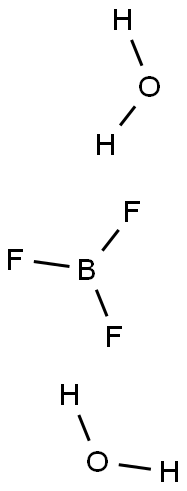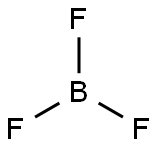Boron trifluoride dihydrate
- CAS NO.:13319-75-0
- Empirical Formula: BF3H4O2
- Molecular Weight: 103.84
- MDL number: MFCD00149901
- EINECS: 603-716-7
- SAFETY DATA SHEET (SDS)
- Update Date: 2024-12-18 14:08:52

What is Boron trifluoride dihydrate?
Chemical properties
colourless liquid
Chemical properties
Boron trifluoride is a nonflammable, colorless gas. Pungent, suffocating odor. Forms dense white fumes in moist air. Shipped as a nonliquefied compressed gas.
General Description
Boron trifluoride dihydrate is a fuming liquid. Boron trifluoride dihydrate may be corrosive to skin, eyes and mucous membranes. Boron trifluoride dihydrate may be toxic by inhalation. Boron trifluoride dihydrate is used as a catalyst in chemical reactions.
Air & Water Reactions
In moist air forms dense white fumes pungent, corrosive to skin, avoid inhalation [Merck 11th ed. 1989].
Reactivity Profile
BORON TRIFLUORIDE is a colorless, strongly irritating, liquid. Upon contact with water, steam or when heated to decomposition, Boron trifluoride dihydrate will produce toxic fluoride fumes. Incompatible with alkyl nitrates, calcium oxide. Reaction with alkali metals or alkaline earth metals (except magnesium) will cause incandescence [Bretherick, 5th ed., 1995, p. 65].
Health Hazard
TOXIC; inhalation, ingestion or contact (skin, eyes) with vapors, dusts or substance may cause severe injury, burns or death. Reaction with water or moist air will release toxic, corrosive or flammable gases. Reaction with water may generate much heat that will increase the concentration of fumes in the air. Fire will produce irritating, corrosive and/or toxic gases. Runoff from fire control or dilution water may be corrosive and/or toxic and cause pollution.
Fire Hazard
Non-combustible, substance itself does not burn but may decompose upon heating to produce corrosive and/or toxic fumes. Vapors may accumulate in confined areas (basement, tanks, hopper/tank cars etc.). Substance will react with water (some violently), releasing corrosive and/or toxic gases and runoff. Contact with metals may evolve flammable hydrogen gas. Containers may explode when heated or if contaminated with water.
Potential Exposure
Boron trifluoride is a highly reactive chemical used primarily as a catalyst in chemical synthesis. It is stored and transported as a gas, but can be reacted with a variety of materials to form both liquid and solid compounds. The magnesium industry utilizes the fireretardant and antioxidant properties of boron trifluoride in casing and heat treating. Nuclear applications of boron trifluoride include neutron detector instruments; boron-10 enrichment and the production of neutroabsorbing salts for molten-salt breeder reactors.
Shipping
UN1008 Boron trifluoride, Hazard class: 2.3; Labels: 2.3—Poisonous gas, 8—Corrosive material, Inhalation Hazard Zone B. Cylinders must be transported in a secure upright position, in a well-ventilated truck. Protect cylinder and labels from physical damage. The owner of the compressed gas cylinder is the only entity allowed by federal law (49CFR) to transport and refill them. It is a violation of transportation regulations to refill compressed gas cylinders without the express written permission of the owner.
Incompatibilities
Boron trifluoride reacts with polymerized unsaturated compounds. Decomposes on contact with water, moist air, and other forms of moisture, forming toxic and corrosive hydrogen fluoride, fluoroboric acid, and boric acid. Reacts violently with alkali and alkaline earth metals (except magnesium); metals, such as sodium, potassium, and calcium oxide, and with alkyl nitrates. Attacks many metals in presence of water.
Waste Disposal
Return refillable compressed gas cylinders to supplier. The owner of the compressed gas cylinder is the only entity allowed by federal law (49CFR) to transport and refill them. Chemical reaction with water to form boric acid, and fluoroboric acid. The fluoroboric acid is reacted with limestone, forming boric acid and calcium fluoride. The boric acid may be discharged into a sanitary sewer system while the calcium fluoride may be recovered or landfilled. Protect cylinder and labels from physical damage.
Properties of Boron trifluoride dihydrate
| Melting point: | 6 °C |
| Boiling point: | 58-60 °C (1.5 mmHg) |
| Density | 1.636 g/mL at 25 °C(lit.) |
| refractive index | n |
| form | Liquid |
| color | Clear colorless to pale yellow |
| Water Solubility | miscible |
| EPA Substance Registry System | Borane, trifluoro-, dihydrate (13319-75-0) |
Safety information for Boron trifluoride dihydrate
| Signal word | Danger |
| Pictogram(s) |
 Corrosion Corrosives GHS05  Skull and Crossbones Acute Toxicity GHS06  Health Hazard GHS08 |
| GHS Hazard Statements |
H302:Acute toxicity,oral H314:Skin corrosion/irritation H330:Acute toxicity,inhalation H372:Specific target organ toxicity, repeated exposure |
| Precautionary Statement Codes |
P260:Do not breathe dust/fume/gas/mist/vapours/spray. P271:Use only outdoors or in a well-ventilated area. P280:Wear protective gloves/protective clothing/eye protection/face protection. |
Computed Descriptors for Boron trifluoride dihydrate
New Products
Tert-butyl bis(2-chloroethyl)carbamate (S)-3-Aminobutanenitrile hydrochloride N-Boc-D-alaninol N-BOC-D/L-ALANINOL N-octanoyl benzotriazole 4-Hydrazinobenzoic acid 3,4-Dibenzyloxybenzaldehyde 3-Nitrobenzaldehyde 1,1’-CARBONYLDIIMIDAZOLE R-2-BENZYLOXY PROPIONIC ACID 1,1’-CARBONYLDI (1,2-4 TRIAZOLE) 4-HYDROXY BENZYL ALCOHOL 3-NITRO-2-METHYL ANILINE (2-Hydroxyphenyl)acetonitrile 5-BROMO-2CYANO PYRIDINE 5,6-Dimethoxyindanone 5-broMo-2-chloro-N-cyclopentylpyriMidin-4-aMine 2-(Cyanocyclohexyl)acetic acid 4-methoxy-3,5-dinitropyridine 2-aminopropyl benzoate hydrochloride 1-(4-(aminomethyl)benzyl)urea hydrochloride tert-butyl 4- (ureidomethyl)benzylcarbamate diethyl 2-(2-((tertbutoxycarbonyl)amino) ethyl)malonate Ethyl-2-chloro((4-methoxyphenyl)hydrazono)acetateRelated products of tetrahydrofuran








You may like
-
 Boron trifluoride dihydrate CAS 13319-75-0View Details
Boron trifluoride dihydrate CAS 13319-75-0View Details
13319-75-0 -
 55441-95-7 99%View Details
55441-95-7 99%View Details
55441-95-7 -
 N-Vinylformamide 99%View Details
N-Vinylformamide 99%View Details
13162-05-5 -
 Chloro Uracil 1820-81-1 99%View Details
Chloro Uracil 1820-81-1 99%View Details
1820-81-1 -
 207557-35-5 99%View Details
207557-35-5 99%View Details
207557-35-5 -
 2-ethyl-6-methyl-3-hydroxypyridine succinate 99%View Details
2-ethyl-6-methyl-3-hydroxypyridine succinate 99%View Details
127464-43-1 -
 2-ETHYLPYRIDINE 100-71-0 99%View Details
2-ETHYLPYRIDINE 100-71-0 99%View Details
100-71-0 -
 181228-33-1 (S)-Methyl 3-amino-2-((tert-butoxycarbonyl)amino)propanote Hydrochloride (DAP-OMe. HCl) 99%View Details
181228-33-1 (S)-Methyl 3-amino-2-((tert-butoxycarbonyl)amino)propanote Hydrochloride (DAP-OMe. HCl) 99%View Details
181228-33-1